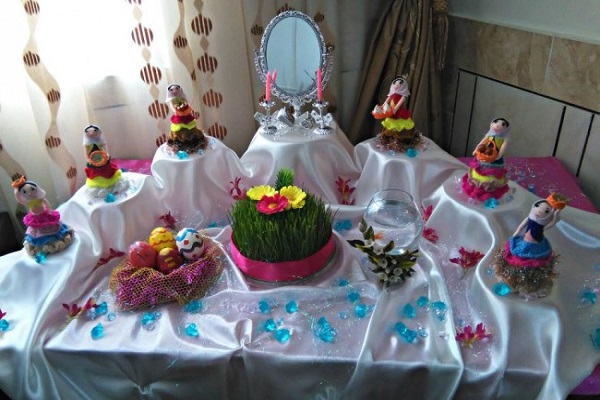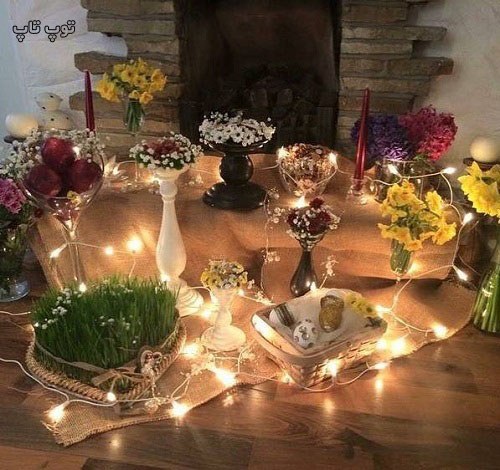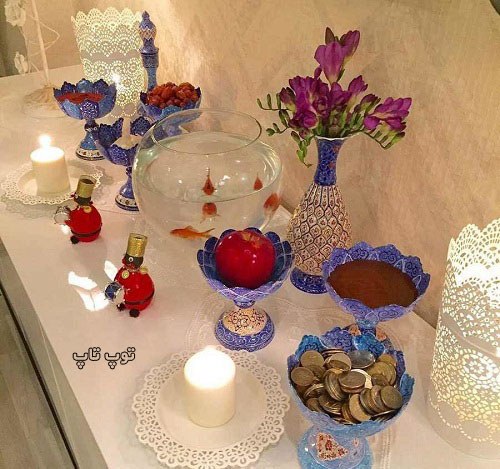متن انگلیسی درباره سفره هفت سین

دوستان گرامی در سال جدید 99-2020 ، این مطلب آپدیت می شود و همانطور که در ادامه شاهد هستید ، این مطلب متن انگلیسی درباره ی سفره ی هفت سین همراه با ترجمه ی فارسی می باشد ، از این مطلب می توانید در فضای مجازی و یا به عنوان یک کار تحقیقی در محیط های آموزشی استفاده نمایید.

Haft-Sine apron from the past to the present day with Eid-e-Nowruz is one of the oldest celebrations left in antiquity with many customs. One of the most famous Iranian Nowruz celebrations is the Haft-Sine table. Even today, the Iranian people prepare the Haft-Sine table several times before the new question is delivered, and foodstuffs begin with the Sin, such as Oleaster, sabzeh, Samano, coin, apple, Sumac, and garlic are on the table
Haft-Sine apron from the past to the present day with Eid-e-Nowruz is one of the oldest celebrations left in antiquity with many customs. One of the most famous Iranian Nowruz celebrations is the Haft-Sine table. Even today, the Iranian people prepare the Haft-Sine table several times before the new question is delivered, and foodstuffs begin with the Sin, such as Oleaster, sabzeh, Samano, coin, apple, Sumac, and garlic are on the table
Iranians by providing Haft-Sine of 7 Amashaspand for the first day of spring, such as water and sabzeh symbols (lighting and enhancement), fire (neurogramma stability), symbol milk (rebirth and resurrection and rebirth), symbol eggs (breed and embryo). ), Symbol of mirrors (Transparency), Oleaster of Symbols (Giving birth and fertility), Apples Symbols (love of secrecy) Pomegranates Symbols (Holiness) Coin Symbols (Blessings) Symbols of Fish (March) Orange Symbols (Earth ball) Mulberry willow flowers featured a special flower of March (Amshaspand Sependarms) on their table
The cause of the number of Haft-Sine Nowruz
In the ancient language, there is a number seven called "Amrdad" which gives the meaning of life and immortality, so the ancient Iranians chose seven words in their sign and set them on the Nowruz reading
Seven were sacred to the ancient Iranians, and they used the number seven for positive, benevolent, and virtuous meanings, such as the seven colors of the rainbow, the seven khans Rostam in the Shahnameh, the seven heavens, the seven climates, the seven days of the week, the seven angels, the seven cities. Love in mysticism, seven figures
Haft-Sin components today
For centuries, in the Eid table of every Iranian, seven varieties of sabzeh and food, the first word of which is "Sin", have been arranged like (garlic, vinegar, sumac, sage, Samano, sabzeh and apples)
.Fish, colored eggs, and mirrors are other components of the Haft-Sine table
There Haft-Sin pomegranates in Parsi that showed fertility and love. They also put red apples in a clear, clear water container to keep the love and fertility going, so we better keep our faith.
Today the Haft Sin table is spread on the ground or on the table, and the families gather around the Haft Sin table and pray for a year full of joy and blessings. Some people keep the Haft-Sine table for thirteen days on New Year's Eve, but others throw the Haft-Sine table on the thirteenth day of Nowruz.
? What are the symbols of the Haft-Sine tablecloths
Brunette or sabzeh
The branch is one of the components of the Haft-Sine table that makes the hearts happy with its color and freshness. Iranians plant wheat or lentils before New Year's Eve and some even prepare vegetables from outside
In ancient Iran, 25 days before Nowruz, the kings erected 12 columns of raw clay and planted each type of grain. If the vegetables were going well they would have had a blessed year. The green symbolizes the vibrancy and greenness of human life and its connection with nature
Perhaps the most beautiful feature of the Haft-Seen tablecloth can be attributed to its Brunette. because of it Brunette the hearts with its color and freshness and makes the New Year dawn more beautiful. The Brunette is also an angel of May and symbolizes pure and infinite waters
Apple
.The apple is a symbol of the health and beauty that Iranians place on the table for home health
Apples are eaten by grandparents or family grandparents on the Haft-Sin table, perhaps because we have all repeatedly witnessed the concern and concern of the mother for the health of the household members. Apple is also a symbol of purity, angel, womanhood, and fertility
Samano
Samano is made from newly sprouted wheat germs and symbolizes the reproduction and fertility of plants and the abundance of good and energetic foods and foods
Oleaster
.Oleasteris another component of the Nowruz whose aroma leaves and blossoms stimulate love and symbolize fertility, love, and affection
Garlic
Another component of the Haft-Sine table is a symbol of microbial detoxification, environmental cleanliness, and body health, as well as the removal of scarring. The Zoroastrians, for this reason, put garlic on the table of Haftsin because they believed that the smell of garlic escaped the court. They peel the garlic and then put it on the table
Vinegar
.Vinegar was also on the table like garlic for cleaning the environment, removing contamination and invalidating magic
Sumac
.Sumac is a component of the Haft-Sin table and symbolizes the love of the heart and the bond of hearts
: There are also other components in Haft-Sine that include
Coins
(Symbol of goodness and blessings and income)
egg
(Symbol of birth and creation and a sign of seed and race)
Mirror
(Lighting icon)
Water and fish
(Blessing in life)
Haft-Sine in The Past
.Rosewater, bread, dates, cheese, sugar, branches of the pomegranate tree, willow, olive, fig, and the bible were other items used in the Haft-Sine table
In some of the historical sources cited, the Iranians had a haft-shin table that was renamed gradually. The constituents of the table were the seven candles, the wine, the pastry, the nectar, the candlestick, the syrup, and the anise, or the branch of the candy
In the Sassanid era, the haft-shin became the common custom of the Iranian people, and the Shamshad was placed on the table along with the rest of the Norouz shins as a sign of vegetation and immortality
After Islam came to Iran and the Arabs invaded and their religion was declared "forbidden" for Wine. So they replaced the vinegar with wine, and Shin turned to the Sin
Haft Sin table is an excuse to spend hours with your family and friends and reflect on the past year and reflect on the year ahead and remember the beauty of life by looking at its components

ترجمه ی همین مقاله به فارسی :
سفره ی هفت سین از گذشته تا به امروز به همراه عید نوروز یکی از کهن ترین جشن های به جا مانده از دوران باستان است که آداب و رسوم زیادی دارد . از مشهورترین مراسم نوروزی ایرانیان، گستردن سفره هفت سین است. امروزه نیز مردم ایران سفره هفت سین را چـند ســاعــت مانــده به زمان تـــحویل ســـــال نو آمـــاده می کنند و مواد خوراکی که ابتدای آنها با سین آغاز می شود از قبیل سبزه ، سنجد ، سمنو، سیب ، سکه، سماق و سیر را بر سر سفره های خود می گذارند.
ایرانیان با تهیه کردن هفت سین به نام امشاسپند و شماره هفت آن برای اولین روز بهار وسایلی مانند سبزه و آب که نماد (روشنایی و نشاط) آتشدان که نماد (پایداری نوروگرما) ، شیر نماد( نوزایی و تولد دوباره )، تخم مرغ نماد (نژاد و نطفه) ، آینه نماد (شفافیت و صفا) ، سنجد نماد (دلدادگی و زایش و باروری)، سیب نماد (رازوارگی عشق) انار و یا شاخه های مقدس آن نماد (تقدس) سکه (برکت و دارندگی) ماهی قرمز نماد (ماه اسفند) نارنج نماد (کره زمین) گل ویژه ی اسفند ماه و یا همان بیدمشک نماد ( امشاسپند سپندارمز) در سفره خود می گذاشتند.
علت عدد سین های نوروزی
در زبان باستانی ایرانیان عدد هفت به نام "امرداد" مقدس است که معنای زندگانی و جاودانگی را می دهد که ایرانیان باستان هفت چیز را به نشانه آن برگزیده اند و بر سفره نوروزی می چینند.
عدد هفت برای ایرانیان باستان مقدس و با ارزش بوده و برای مفاهیم مثبت، خوش اقبالی و فال نیک استفاده از عدد هفت استفاده می کردند مثلا هفت رنگ زیبای رنگین کمان، هفت خان قدرتمند رستم در شاهنامه، هفت آسمان، هفت اقلیم، هفت روز هفته، هفت فرشته، هفت شهر عشق در عرفان، هفت پیکر و ... .
اجزای هفت سین امروزه
قرن های بسیار زیادی است که در سفره ی عید هر ایرانی و فارسی زبان، هفت گونه خوردنی و سبزه که حرف نخست آنها «سین» می باشد ، مثل سیر ، سماق، سرکه، سنجد، سمنو و سبزه و سیب) چیده می شود
ماهی ، تخم مرغ رنگ شده و به اصطلاح رنگی، آینه نیز از اجزای دیگر سفره هفت سین تاریخی هستند.
در هفت سین پارسی و اصیل انار نیز وجود داشته است که نشانه باروری و عشق به دیگران بوده است . همچنین زرتشتیان باستان سیب سرخ را نیز درون ظرف آب پاک و زلال می گذاشتند تا عشق و باروری همچنان پاینده بماند پس بهتر است آیین خود را حفظ کنیم.
امروزه با تعویض عصر سفره هفت سین را روی زمین و یا روی میز گسترده می کنند و افراد یک خانواده دور سفره هفت سین جمع می شوند و برای داشتن سالی با شکوه پر از شادی و خیرو برکت دعا کرده و امید می گسترانند.. برخی از مردم ایران تنها همان روز عید اما برخی دیگر از مردم سفره هفت سین را سیزده روز نگه می دارند و در روز سیزده نوروز که به آن سیزده به در می گویند، سبزه ی سفره هفت سین را به آب می اندازند.
سین های سفره هفت سین نماد چیست؟
سبزه
یکی از اجزای اصلی سفره هفت سین سبزه است که با لطافت و تازگی خود دل ها را شادمان و خوشحال می کند . ایرانیان قبل از سال نو و در روزهای پایانی سال گندم و یا غلات می کارند و برخی نیز سبزه را از بیرون به صورت آماده تهیه می کنند.
در زمان ایران باستان بیست و پنج روز قبل از نوروز به دستور پادشاهان دوازده ستون از خشت خام می ساختند و بر هرکدام یک نوع غله می کاشتند . اگر سبزه ها خوب می رویید نشان از این بود که سال پر برکتی در پیش داشتند . سبزه نماد سرسبزی و شادابی و نشانگر زندگی بشر و پیوند او با طبیعت است.
شاید زیباترین ویژگی سفره هفت سین را میتوان به وجود سبزه آن دانست، به این دلیل که سبزه با رنگ و طراوت خود دلها را شاد میکند و با نگاه به آن می توان طلوع سال جدید را زیباتر میکند. سبزه همچنین نماد فرشته اردیبهشت و آبهای پاک و بیکران است.
سیب
سیب، نمادی از سلامتی و زیبایی در انسان است که ایرانیان باستان آن را برای حفظ سلامتی اعضای خانه بر سر سفره قرار می دادند.
سیب را پدربزرگ یا مادربزرگ خانواده بر سفره هفت سین می گذارد کهمی تواند به آن خاطر باشد که همه ما بارها شاهد دلواپسی و نگرانی مادر خانواده برای حفظ سلامتی اعضای خانه بوده ایم. سیب همینطور نماد پاکی، فرشته، زن و باروری است.
سمنو
سمنو از جوانه های گندم تازه و سبز شده تهیه می شود و سمبل تولد و زندگی دوباره گیاهان و همچنین فراوانی غذا و خوردنی های خوب و پر انرژی است.
سنجد
سنجد یکی دیگر از اجزای هفت خان هفت سین نوروزی است که بوی خوش برگ، شاخه ها و شکوفه های آن باعث تحرک و عشق و لطف و همچنین نماد زایندگی ، عشق و دلبستگی می باشد.
سیر
سیر یکی دیگر از اجزای اصلی سفره هفت سین است که نماد سلامتی و میکروب زدایی و پاکیزگی محیط زیست و سلامت انسان و نیز زدودن حسادت است. زرتشتیان به این علت سیر را بر سفره های هفت سین خود می گذاشتند که معتقد بودند بوی تند سیر دیوان و ارواح را می گریزاند.
آنها سیر را پوست می کنند و سپس آن را بر سر سفره هفت سین می گذاتند.
سرکه
سرکه نیز همانند سیر برای حفظ پاکی محیط، زدودن میکروب ها و آلودگی، باطل کردن سحر و جادو بر سر سفره قرار می گیرد.
سماق
سماق نیز یکی دیگر از اجزای اصلی سفره هفت سین و نماد عشق مهر و پیوند میان دل ها و نیز عشق و علاقه می باشد.
در سفره هفت سین نوروزی اجزای تشریفاتی دیگری نیز وجود دارد که عبارتند از :
سکه تازه مضوب شده
( نمادی از خیر و برکت و درآمد )
تخم مرغ رنگی
( نماد زایش و آفرینش و نشانه ای از نطفه و نژاد)
آینه
( نماد روشنایی )
آب و ماهی قرمز
( برکت در زندگی )
هفت سین در گذشته
گلاب مخصوصا گل محمدی ، نان، رطب ، پنیر ، شکر ، شاخه های درخت مقدس انار، بید، زیتون، انجیر و کتاب مقدس از وسایل دیگر مورد استفاده درسفره هفت سین بود.
در برخی از منابع تاریخی آورده شده ایرانیان در زمان های قدیم سفره هفت شین داشته اند که به تدریج تغییر نام داده است . اجزای تشکیل دهنده سفره هفت شین شمع، شراب ، شیرینی ، شهد، شمشاد، شربت و شقایق یا شاخه نبات، بودند.
در زمان ساسانیان هفت شین رسم متداول مردم ایران شد و شمشاد در کنار بقیه شین های نوروزی، به نشانه سبزی و جاودانگی بر سر سفره قرار گرفت.
پس از آمدن اسلام به ایران و حمله اعراب بی تمدن و حرام اعلام شدن «شراب» آنها، خواهر و همزاد شراب را که سرکه می باشد ، بر سر سفره قرار می دادند و اینگونه شین به سین تغییر پیدا کرد.
سفره هفت سین بهانه ای است تا ساعاتی در کنار خانواده و دوستان خود بنشینید و به سالی که هم اکنون به اتمام رسیده فکر کنید و سالی را که در پیش دارید مجسم کرده و با نگاه کردن آن زیباییهای زندگی را به یاد بیاورید.
سایر مطالب پیشنهادی :
آداب و رسوم عید نوروز به زبان انگلیسی با ترجمه
خاطرات عید نوروز به زبان انگلیسی + ترجمه
مجموعه شعر زیبا در مورد سفره هفت سین
جدیدترین تزیین سفره هفت سین 99 ، خاص و دلنشین